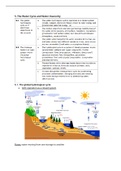5. The Water Cycle and Water Insecurity
5. 1. The global hydrological cycle
a. GHC operation as a closed system
Flows: water moving from one storage to another
, - Transpiration: release of water through plant leaves
- Throughflow: lateral unsaturated flow of water in the soil zone
- Precipitation: any liquid or frozen water that forms in the atmosphere and falls back to
the Earth
- Interception: part of the rainfall that is intercepted by the earth's surface and which
subsequently evaporates
- Surface runoff: flow of water occurring on the ground surface when excess rainwater
when the land is saturated
- Groundwater flow: part of streamflow that has infiltrated the ground
- Infiltration: movement of water into the ground from the surface.
- Percolation: movement of water past the soil going deep into the groundwater
- Evaporation: process by which a liquid turns into a gas.
Closed system: there are no external inputs or outputs, meaning that the total amount of
water in the world hydrologic cycle does not change as no water can leave or enter
- Inputs: water coming into the system
- precipitation
- Outputs: water leaving the system
Stores: water stored in the system
- Groundwater storage: Large amounts of water are stored in the ground
- Surface storage: water kept in oceans, lakes, reservoirs, and glaciers
- Soil moisture: the water held in the spaces between soil particles.
The cycle is driven by solar and gravitational potential energy. This power comes from the Sun
as heat and gravity which causes rivers to flow downhill and precipitation to fall.
b. Relative importance of water stores
Stores: where water is held. The 4 main stores:
1. The oceans
2. Glaciers and ice sheets
3. Surface runoff
(umbrella term for a number of land-based stores, including rivers, lakes,
groundwater, and moisture held in the soil and vegetation)
4. The atmosphere
Of the freshwater stores:
- The cryosphere is the largest, holds 69% of all freshwater
- Groundwater holds 30%
- Less than 1% is stored in the biosphere
Flows: transfers of water from one store to another
, - Oceans and atmosphere
- Atmosphere and landmasses
- Landmasses and oceans
Flux: rate of flow between stores
c. Global water budget limits
The global water budget takes into account all the water in all stores and transfers of the GHC.
Most significantly, only 2.5% of all water is freshwater and the rest is in oceans. Further, only
1% of freshwater is ‘easily accessible’ as 70% is locked up in glaciers and ice sheets.
Residence time in different stores:
● Biospheric water: 1 week
● atmospheric water: 1.5 weeks
● River channels: 2 weeks
● Soil moisture: 2 weeks -> 1 year
● Swamps: 1 -> 10 years
● Lakes and reservoirs: 10 years
● Ice caps and glaciers: 1000 years
● Oceans and seas: 4000 years
● Groundwater: 2 weeks -> 10 000 years
Water distribution:
Total estimated: 1385 million km3
Not distributed equally amongst the hydrosphere, biosphere, atmosphere, geosphere and
cryosphere.
Store Volume (1000s hm3) % of total % of freshwater
Oceans 1 335 040 96
Icecaps 26 350 1.9 63
groundwater 15 300 1.1 36
Rivers and lakes 178 0.1 0.42
Soil moisture 122 0.009 0.29
Atmospheric moisture 13 0.0009 0.03
Total freshwater: 41963000
Bluewater: stored in rivers, streams, lakes and groundwater in liquid form (visible)
Greenwater: stored in soil and vegetation (invisible)
Water in ...
, - Fossil water: ancient, deep groundwater made from pluvial periods in the geological
past
- Cyrosphere: those areas of the world where water is frozen as snow or ice
… is non-renwable. This means that these stores are not replenished at all or for a very long
time by nature.
The smallness of the figure for all water accessible to humans for use (1%), emphasises the idea
that it is a finite resource, with excess demand, meaning it needs extreme careful
management.
5. 2. Drainage basins
a. The hydrological cycle
Drainage basin are also called catchment areas because they collect all the precipitation that
falls in the watershed. They are open systems: inputs are not governed by outputs
- Inputs: precipitation
- Outputs: evaporation, transportation, surface runoff or overland flow into the sea
Inputs:
Main input is precipitation, which can vary in:
- Form: rain, snow, hail… affect rate of entering the drainage system
- Amount: affect amount of water and fluxes
- Intensity: affects likelihood of flooding
- Seasonability: results in different operation levels at different times
- Distribution: tributaries can start in different climate zones
There are different types:
● Convectional:
1. Solar energy heats the surface of the Earth, causing water to evaporate into vapour.
2. The air above it rises as it heats up.
3. At a height it will cool down and condense into large cumulonimbus clouds.
4. Heavy rainstorms occur. Usually include thunder and lightning due to the electrical
charge created by unstable conditions.
Widespread in areas where the ground is heated by the hot sun, such as the tropics.
● Cyclonic:
1. 2 air masses of different temperatures meet.
2. Warm air and cool air do not mix, as they have different densities.
3. As the warm air rises over the heavier cool air, it cools and creates a front, clouds form
and produce rain.
● Orographic (relief):
1. Air is forced to cool when it rises over relief features in the landscape such as hills or
mountains.
2. As it rises, it cools, condenses and fall back as rain.




